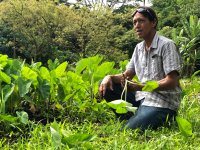A Framework for Educational Equity
An elementary school in Hawai‘i connects national educational goals to indigenous cultural values and practices.
Your content has been saved!
Go to My Saved Content.In 2015, Hawaiʻi’s Department of Education took steps to address educational equity by implementing interdependent learning outcomes called Nā Hopena Aʻo or HĀ. [Editor’s note: Our software does not support the use of the kahakō macron, which is used in Hawaiian to indicate a long vowel.] The HĀ framework looks different in each school community because all stakeholders—students, teachers, staff, parents, and community members—work together to build a strengthened sense of belonging, responsibility, excellence, well-being, aloha, and Hawaiʻi, include Kanaka Maoli (Native Hawaiian) culture, language, history, and values.
Why the HĀ Framework Matters
To understand why this framework is important, some context is necessary. In 1896 the Hawaiian language was banned in public schools in Hawaiʻi, and in 1924, the Hawaiʻi Department of Education created English standard schools and classrooms in certain areas of the islands for students who spoke standard English. This essentially created a two-tiered school system, with one tier for those students from affluent families, who spoke standard English, and another tier for those from immigrant or Native Hawaiian families, who did not.
In light of this not-so-distant history and the lingering impacts of those classist and racist decisions, it is essential that the Hawaiʻi Department of Education actively works toward equity, and it’s particularly necessary that this work focuses on Hawaiian cultural values and practices that were long suppressed.
While a focus on indigenous frameworks is not new in some of our public charter schools, it is new to Hawaiʻi’s traditional public schools and DOE offices and policies. One traditional public school now seeking to highlight place-based learning and culturally relevant pedagogy is Kāneʻohe Elementary.
An Innovation Academy
Kāneʻohe Elementary’s sixth-grade students begin their mornings with an oli in Hawaiian. They stand facing the sun rising over Kāneʻohe Bay with their backs to the steep green cliffs of the Koʻolau mountain range as they chant to their teachers that they are ready for school. Their teachers chant a welcome, and then most students and teachers head inside.
One group stays behind to do an aloha circle, which is modeled on restorative circles. These sixth graders are in the school’s Innovation Academy, a culturally informed STEM program. It is a heterogeneous mix of students with a general education teacher, an inclusion teacher, and an occasional adult volunteer.
The Innovation Academy is a partnership between teacher Bella Finau-Faumuina and her co-teacher, Sarah Passoff. The idea for culturally relevant pedagogy came to Finau-Faumuina, or Kumu Bella as she’s called by faculty and students alike, when she realized that she wasn’t reaching her students by teaching the school’s curriculum. That packaged curriculum had references to snow and other things her students had difficulty relating to. Kumu Bella, a special education teacher, felt that she couldn't let her students fail at something she knew they could learn if only they could connect to it in an authentic way.
Once a week, the students in the Innovation Academy are driven to nearby Luluku Farms in Hoʻomaluhia Botanical Garden, where they work with caretaker and farmer Mark Paikuli-Stride. The students either work in the lo’i (taro patch) or cook for the students doing the farm work. Every few weeks they switch roles.
Paikuli-Stride explains that part of what he wants students to get from the farm is the knowledge that they can live off the land. Making food for each other drives home the connection between the work in the loʻi and how we feed our communities.
The Innovation Academy works with companies in STEM fields via a community partnership with Education Incubator, based on the work the students are doing at Luluku Farms. For example, two students are in the process of designing a water wheel to produce electricity for the off-the-grid farm, and Education Incubator will connect them with fabricators who can make their design. That’s part of what is so powerful about such partnerships: Students can imagine something, design it, and then see it come to life.
A Promising Start
Kumu Bella says there are three main things the academy does to nourish student success:
- Students have autonomy and choice;
- Students have access to differentiated, small-group instruction when needed; and
- Students build relationships through storytelling, circle time, and working the land.
The school’s data is limited because the Innovation Academy is only in its second year and has a small sample size of 23 students, but the program so far shows better average results in attendance and discipline than the school at large. Students’ average math and reading scores are lower than the school average, but their average growth is higher compared to the average growth of the school.
Hard data aside, Principal Derek Minakami stresses that test scores do not drive decisions about the academy, emphasizing that he sees signs that the Innovation Academy is working: students who were chronically absent arriving to school early, parents saying they’ve seen remarkable changes in their child’s disposition.
The Innovation Academy will expand next year beyond grade 6 to include grades 4 and 5, and also out to a nearby intermediate school for grade 7.
Looking Back to Move Forward
Conversations about how to achieve educational equity often leave out indigenous peoples and their histories. To change this, start by viewing local history and your school’s history though a settler colonist lens. Uncover the history of the place that your school district now occupies and share it with all stakeholders. This is a meaningful step in transforming the current educational landscape to serve all learners.
While a great deal of information may be found through research, ideally you would go out into your community and speak with cultural practitioners to bring their shared histories and experiences into schools so students gain a deeper sense of belonging and place.
